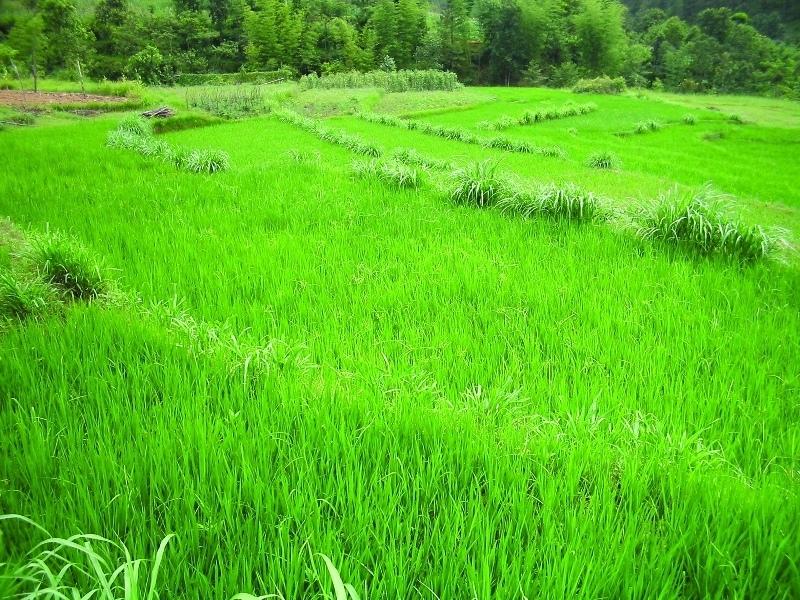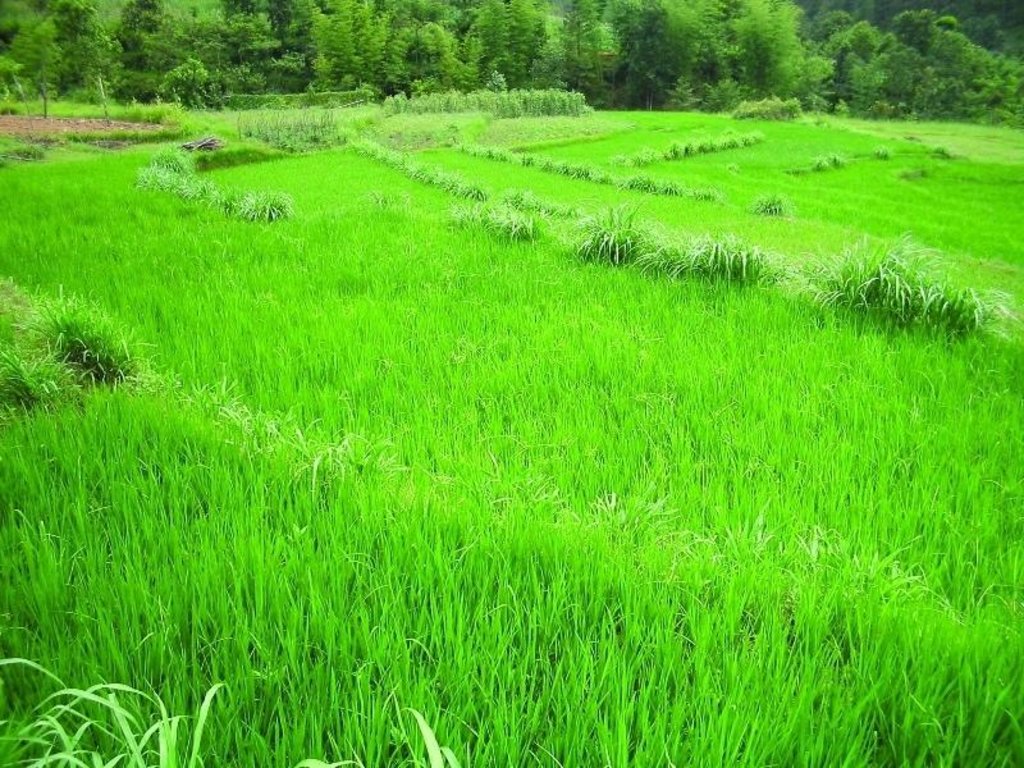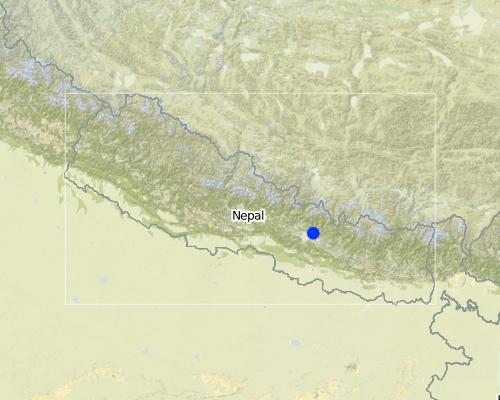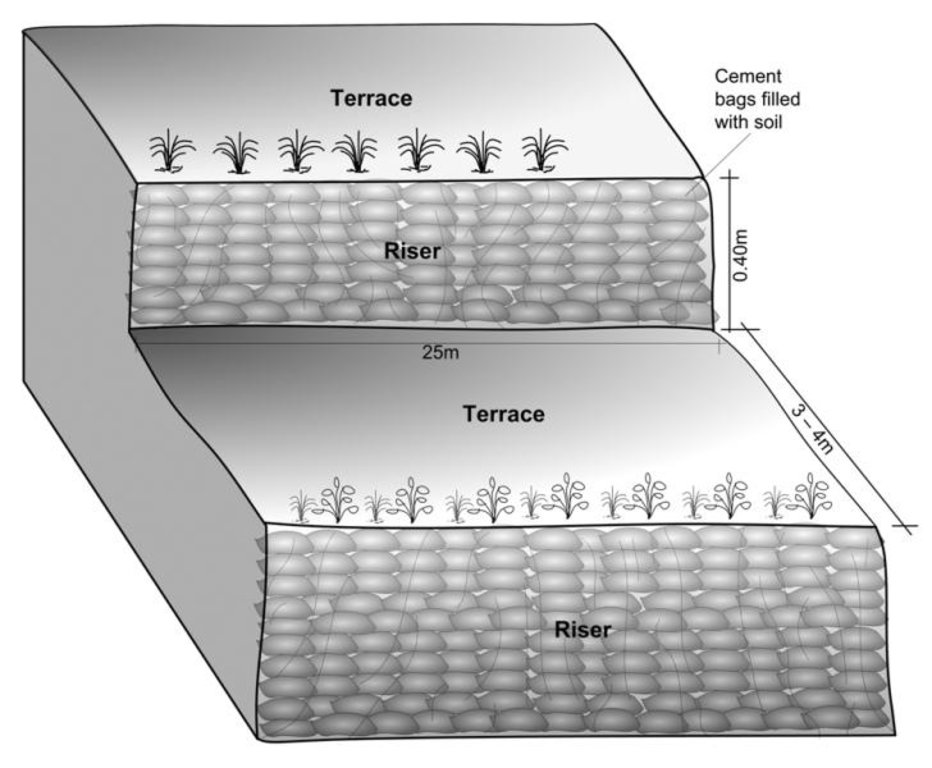Improved terraces [Nepal]
- Creation:
- Update:
- Compiler: Madhav Dhakal
- Editor: –
- Reviewer: David Streiff
GARA SUDHAR- Nepali
technologies_1499 - Nepal
View sections
Expand all Collapse all1. General information
1.2 Contact details of resource persons and institutions involved in the assessment and documentation of the Technology
SLM specialist:
SLM specialist:
Shreshta Bhubhan
977015525313
bhshreshta@icimod.org.np
PARDYP/ICIMOD
GPO Box. 3226 Kathmandu Nepal
Nepal
SLM specialist:
Nakarmi Gopal
977015525313
gnakarmi@icimod.org.np
PARDYP/ICIMOD
GPO Box. 3226 Kathmandu Nepal
Nepal
SLM specialist:
Merz Juerg
977015525313
jmerz@icimod.org.np
PARDYP/ICIMOD
GPO Box. 3226 Kathmandu Nepal
Switzerland
SLM specialist:
Shrestha Smriti
977015525313
smshrestha@icimod.org.np
PARDYP/ICIMOD
GPO Box. 3226 Kathmandu Nepal
Nepal
SLM specialist:
Adhikari Krishna.Raj
977015525313
mdhakal@icimod.org.np
PARDYP/ICIMOD
GPO Box. 3226 Kathmandu Nepal
Nepal
SLM specialist:
Shah P.B.
977015525313
pshah@icimod.org.np
PARDYP/ICIMOD
GPO Box. 3226 Kathmandu Nepal
Nepal
SLM specialist:
Bhuchar Sanjeev
977015525313
sbhuchar@icimod.org.np
PARDYP/ICIMOD
GPO Box. 3226 Kathmandu Nepal
Nepal
SLM specialist:
Singh Bijendra K
bijendra@hotmail.com
District Soil Conservation Office Dhulikhel
Kavrepalanchowk, Nepal
Nepal
land user:
Thapa Kalpana
Hokse VDC, Kubinde
Nepal
land user:
Thapa Gore
Hokse VDC, Kubinde
Nepal
land user:
Thapa Leela
Hokse VDC, Kubinde
Nepal
land user:
Tamang Indra
Hokse VDC, Kubinde
Nepal
SLM specialist:
Name of project which facilitated the documentation/ evaluation of the Technology (if relevant)
People and Resource Dynamics Project, Nepal (PARDYP)Name of the institution(s) which facilitated the documentation/ evaluation of the Technology (if relevant)
ICIMOD International Centre for Integrated Mountain Development (ICIMOD) - NepalName of the institution(s) which facilitated the documentation/ evaluation of the Technology (if relevant)
District Soil Conservation Office (DSCO) - Nepal1.3 Conditions regarding the use of data documented through WOCAT
When were the data compiled (in the field)?
07/02/2003
The compiler and key resource person(s) accept the conditions regarding the use of data documented through WOCAT:
Ja
2. Description of the SLM Technology
2.1 Short description of the Technology
Definition of the Technology:
Hillside forward-sloping terracing and stabilisation using structural and vegetative measures
2.2 Detailed description of the Technology
Description:
This technology addresses the soil erosion and water runoff problems associated with traditional outward-sloping terraces by reshaping the land into a series of level or gently sloping platforms across the slope. This technology is a variant of sloping land agricultural technology (SALT) or contour hedgerow technology. Nitrogen-fixing hedgerow species and quality fodder grass species, which bind the soil, are cultivated along terrace riser margins to improve terrace stability. This also enhances soil fertility and increases fodder availability. The plants are grown in either single or multiple layers. The practice is applied under rainfed conditions and is culturally acceptable and affordable. After establishment, the technology also addresses the problems of fodder scarcity making it easier and less time consuming for women and
girls to gather fodder.
The hedgerow and grass species are established between January and June. Complete establishment of this technology may take one year. The first step in creating the terraces is to build retaining walls using cement bags filled with soil which are then supported with bamboo cuttings along the contour (= future terrace risers). This divides the land into the planned terrace sections. The length and width of the terraces depends on the size and shape of the original field. Secondly, the soil is excavated from the upper part of the terraces and is used to build up the lower part above and behind the terrace riser wall to create a level bed. The fertile top soil must be kept aside and later spread over the newly terraced fields. The final step is to plant grass and hedgerow species on the outermost margins of the terrace above the risers.
Maintenance involves slicing the terrace risers once or twice a year with a spade, and smoothing off rills that appear on the surface of terraces after the premonsoon and monsoon periods. Hedgerows should be cut regularly but not more than twice a year, normally to a height of about 50 cm. Grasses should be cut about once to twice a month depending on their rate of growth.
The technology is applied under humid subtropical climate conditions (1300 mm annual rainfall with about 80% of it falling in the monsoon months of June - September). The case study area has hill slopes of 16-30% that are mostly highly erodible red soils (FAO classification: luvisols).
2.3 Photos of the Technology
2.5 Country/ region/ locations where the Technology has been applied and which are covered by this assessment
Country:
Nepal
Further specification of location:
Hokse VDC ward no2
Map
×2.6 Date of implementation
If precise year is not known, indicate approximate date:
- more than 50 years ago (traditional)
2.7 Introduction of the Technology
Specify how the Technology was introduced:
- through projects/ external interventions
Comments (type of project, etc.):
It is a combination of traditional knowledge and practice along with new scientific research findings from within the region and elsewhere, e.g., N-fixing fodder species related information from Phillipines.
3. Classification of the SLM Technology
3.1 Main purpose(s) of the Technology
- reduce, prevent, restore land degradation
3.2 Current land use type(s) where the Technology is applied

Cropland
- Annual cropping
Main crops (cash and food crops):
major cash crop: Potato and tomato
major food crop: Maize and wheat
other: Beans and chilli
Comments:
Major land use problems (compiler’s opinion): The major land use problem in the area documented is the small per capita cropping landholding size. The fields are mostly rainfed and have low soil fertility and acidity problems and are susceptible to erosion. The high intensity of rainfall leads to considerable soil loss (rill and gully erosion) at the beginning of rainy seasons.
Major land use problems (land users’ perception): The production of the cultivable land is declining. Management of slopes is inappropriate, the farmers experience serious constraints in terms of adopting better farming options, e.g., cash crops (due to fertility / erosion and soil moisture problems).
Type of cropping system and major crops comments: Rice Premonsoon and monsoon( March- Novevember ) or Maize intercropped with Beans (April to August) ,Wheat and Potato ( September to January/ February) ,Tomato (January/February- April )
3.3 Further information about land use
Water supply for the land on which the Technology is applied:
- rainfed
Number of growing seasons per year:
- 3
Specify:
Longest growing period in days: 150; Longest growing period from month to month: Jun - Oct; Second longest growing period in days: 120; Second longest growing period from month to month: Nov - Feb
3.4 SLM group to which the Technology belongs
- cross-slope measure
- water diversion and drainage
3.5 Spread of the Technology
Specify the spread of the Technology:
- evenly spread over an area
If the Technology is evenly spread over an area, indicate approximate area covered:
- < 0.1 km2 (10 ha)
Comments:
Total area covered by the SLM Technology is 0.0126 km2.
The technology has been evaluated on the bases of village as a unit. Therefore the values calculated in terms of land use percentages is on the bases of village( Kubinde) data.
3.6 SLM measures comprising the Technology

vegetative measures
- V1: Tree and shrub cover

structural measures
- S1: Terraces
3.7 Main types of land degradation addressed by the Technology

soil erosion by water
- Wt: loss of topsoil/ surface erosion
- Wg: gully erosion/ gullying

water degradation
- Ha: aridification
Comments:
Main type of degradation addressed: Wt: loss of topsoil / surface erosion, Wg: gully erosion / gullying
Secondary types of degradation addressed: Ha: aridification
Main causes of degradation: other natural causes (avalanches, volcanic eruptions, mud flows, highly susceptible natural resources, extreme topography, etc.) specify (Soil erosion due to high intensity rainfall during rainy season and uneven distribution of rainfall during lean season.), education, access to knowledge and support services (lack of knowledge - with regards to SWC measures)
Secondary causes of degradation: other human induced causes (specify) (agricultural causes - lack of improved farming options), poverty / wealth (lack of captial - realted to inmproved seeds, technologies etc.)
3.8 Prevention, reduction, or restoration of land degradation
Specify the goal of the Technology with regard to land degradation:
- reduce land degradation
4. Technical specifications, implementation activities, inputs, and costs
4.1 Technical drawing of the Technology
4.2 Technical specifications/ explanations of technical drawing
Schematric view after intervention
[terracing and vegetative measures]
Riser slope: 75 degree
Terrace slope: ~ 2 degree
Location: Kubinde
Technical knowledge required for field staff / advisors: high
Technical knowledge required for land users: moderate
Main technical functions: control of concentrated runoff: impede / retard, reduction of slope angle, reduction of slope length
Secondary technical functions: increase of infiltration, increase / maintain water stored in soil, increase in soil fertility
Vegetative measure: on risers
Vegetative material: T : trees / shrubs, G : grass
Number of plants per (ha): 2500
Vertical interval between rows / strips / blocks (m): 1.5
Spacing between rows / strips / blocks (m): 3 to 4
Vertical interval within rows / strips / blocks (m): 0.25
Vegetative measure: Vegetative material: T : trees / shrubs, G : grass
Vegetative measure: Vegetative material: T : trees / shrubs, G : grass
Vegetative measure: Vegetative material: T : trees / shrubs, G : grass
Trees/ shrubs species: Sunhemp(Crotalaria juncea),Tephrosia (Tephrosia candida) and Flemingia (Flemingia microphylla)
Grass species: Napier(Pennisetum purpureum),Molasses (Melinis minutiflora) and Stylo(Stylosanthes guianensis)
Slope (which determines the spacing indicated above): 5.00%
If the original slope has changed as a result of the Technology, the slope today is (see figure below): 5.00%
Gradient along the rows / strips: 75.00%
Terrace: bench level
Vertical interval between structures (m): 1.5
Width of ditches/pits/dams (m): 3-4
Length of ditches/pits/dams (m): 10-15
Construction material (earth): Cement bag filled with soil, Bamboo nets were used to make risers.
Slope (which determines the spacing indicated above): 30%
If the original slope has changed as a result of the Technology, the slope today is: 5%
Vegetation is used for stabilisation of structures.
4.3 General information regarding the calculation of inputs and costs
Specify currency used for cost calculations:
- US Dollars
Indicate exchange rate from USD to local currency (if relevant): 1 USD =:
-1.0
Indicate average wage cost of hired labour per day:
1.40
4.4 Establishment activities
| Activity | Type of measure | Timing | |
|---|---|---|---|
| 1. | Area estimation ( for vegetative measures) | Vegetative | before rainy seasonn/lean period (February) |
| 2. | Selection of fodder grass species | Vegetative | Before rainy season (Feb) |
| 3. | Planting of grasses and hedgerow species on the outward margins | Vegetative | During rainy season. |
| 4. | Establishment of riser, using cement bags (filled with soil) and bamboo culms for terrace stabilisation | Structural | Beginning of rainy season(May) |
| 5. | Terrace leveling:The length and width of the terraces depends on the size and shape of the field. Excavate soil from the upper part of the terrace field and use it to build up the lower part behind the terrace riser wallt creat a level plateform/bed. | Structural | Beginning of rainy season(May) |
4.5 Costs and inputs needed for establishment
| Specify input | Unit | Quantity | Costs per Unit | Total costs per input | % of costs borne by land users | |
|---|---|---|---|---|---|---|
| Labour | Labour | ha | 1.0 | 970.0 | 970.0 | 50.0 |
| Equipment | Total costs | ha | 1.0 | 92.0 | 92.0 | 100.0 |
| Plant material | Seeds | ha | 1.0 | 25.0 | 25.0 | |
| Plant material | Seedlings | ha | 1.0 | 30.0 | 30.0 | |
| Plant material | Bamboo | culms | 80.0 | 1.0 | 80.0 | 50.0 |
| Construction material | Cement bags | ha | 1.0 | 80.0 | 80.0 | 50.0 |
| Other | Supervision charge | ha | 1.0 | 10.5 | 10.5 | |
| Total costs for establishment of the Technology | 1287.5 | |||||
Comments:
Duration of establishment phase: 12 month(s)
4.6 Maintenance/ recurrent activities
| Activity | Type of measure | Timing/ frequency | |
|---|---|---|---|
| 1. | Hedgerow/grass maintenance: Hedgerows are cut regularly but not | Vegetative | Grass is cut once or twice a month. |
| 2. | (Re)plantation of hedge species if necessary | Vegetative | Before monsoon /1*/year |
| 3. | Surface and riser maintenance: smooth the surface/rills on the | Structural | after pre monsoon and after monsoon/2 */ year ,Jun |
4.7 Costs and inputs needed for maintenance/ recurrent activities (per year)
| Specify input | Unit | Quantity | Costs per Unit | Total costs per input | % of costs borne by land users | |
|---|---|---|---|---|---|---|
| Labour | Labour | ha | 1.0 | 310.0 | 310.0 | 100.0 |
| Equipment | Tools total costs | ha | 1.0 | 20.0 | 20.0 | 100.0 |
| Plant material | Seeds | ha | 1.0 | 6.0 | 6.0 | 100.0 |
| Plant material | Seedlings | ha | 1.0 | 6.0 | 6.0 | 100.0 |
| Total costs for maintenance of the Technology | 342.0 | |||||
Comments:
Machinery/ tools: Spade, Shovel, spade
All costs and amounts... are very roughly estimated by the technicians and authors.
Costs for structural measures are calculated considering the volume of excavated earth. 1 cubic meter excavated earth = 0.69 USD (labour cost). For vegetative measures it is normally based on daily wage = 1.4 USD as in 2006.
Labour cost is the major expenditure in the initial stage.
costs for tools for establishment are representative for the situation when tools for implementation of the SWC technology are not available (normally they are since the technology does not require very specific tools).
4.8 Most important factors affecting the costs
Describe the most determinate factors affecting the costs:
In case of projects interested in promoting this technology in the region, the labour cost is the major expenditure in the initial stage.The labour charges are decided by the district soil conservation office.
5. Natural and human environment
5.1 Climate
Annual rainfall
- < 250 mm
- 251-500 mm
- 501-750 mm
- 751-1,000 mm
- 1,001-1,500 mm
- 1,501-2,000 mm
- 2,001-3,000 mm
- 3,001-4,000 mm
- > 4,000 mm
Specify average annual rainfall (if known), in mm:
1304.00
Agro-climatic zone
- humid
Thermal climate class: subtropics
5.2 Topography
Slopes on average:
- flat (0-2%)
- gentle (3-5%)
- moderate (6-10%)
- rolling (11-15%)
- hilly (16-30%)
- steep (31-60%)
- very steep (>60%)
Landforms:
- plateau/plains
- ridges
- mountain slopes
- hill slopes
- footslopes
- valley floors
Altitudinal zone:
- 0-100 m a.s.l.
- 101-500 m a.s.l.
- 501-1,000 m a.s.l.
- 1,001-1,500 m a.s.l.
- 1,501-2,000 m a.s.l.
- 2,001-2,500 m a.s.l.
- 2,501-3,000 m a.s.l.
- 3,001-4,000 m a.s.l.
- > 4,000 m a.s.l.
5.3 Soils
Soil depth on average:
- very shallow (0-20 cm)
- shallow (21-50 cm)
- moderately deep (51-80 cm)
- deep (81-120 cm)
- very deep (> 120 cm)
Soil texture (topsoil):
- fine/ heavy (clay)
Topsoil organic matter:
- medium (1-3%)
- low (<1%)
If available, attach full soil description or specify the available information, e.g. soil type, soil PH/ acidity, Cation Exchange Capacity, nitrogen, salinity etc.
Soil texture (topsoil): Clay loam
Soil fertility is low
Soil drainage / infiltration is good but when rigid surface, then low infiltration
Soil water storage capacity is low - medium
5.4 Water availability and quality
Availability of surface water:
poor/ none
Water quality (untreated):
poor drinking water (treatment required)
Comments and further specifications on water quality and quantity:
Availability of surface water: Sloping land , water available at downstream
Water quality (untreated): More in rainy season (June- September), less in April/May; source: natural spring
5.6 Characteristics of land users applying the Technology
Market orientation of production system:
- subsistence (self-supply)
- mixed (subsistence/ commercial
Off-farm income:
- 10-50% of all income
Relative level of wealth:
- poor
- average
Individuals or groups:
- individual/ household
Level of mechanization:
- manual work
- animal traction
Gender:
- women
- men
Indicate other relevant characteristics of the land users:
Land users applying the Technology are mainly common / average land users
Population density: 200-500 persons/km2
Annual population growth: 2% - 3%
2% of the land users are rich and own 10% of the land.
3% of the land users are average wealthy and own 15% of the land (off farm employment).
95% of the land users are poor and own 75% of the land.
Off-farm income specification: In most farm households off-farm income plays at least a minor and increasingly a major role. Occasional opportunities for off-farm income present themselves in the form of daily
Market orientation of production system: For subsistence there is: Rice, maize and wheat. Potato and tomato are for market or subsitence as well.
Level of mechanization: Land preparaion, planting,weeding and harvest is manual labour, but land preparation can also happen with animal traction.
5.7 Average area of land owned or leased by land users applying the Technology
- < 0.5 ha
- 0.5-1 ha
- 1-2 ha
- 2-5 ha
- 5-15 ha
- 15-50 ha
- 50-100 ha
- 100-500 ha
- 500-1,000 ha
- 1,000-10,000 ha
- > 10,000 ha
Is this considered small-, medium- or large-scale (referring to local context)?
- medium-scale
Comments:
Land fragmentation due to poulation growth, mostly of rainfed type
5.8 Land ownership, land use rights, and water use rights
Land ownership:
- individual, titled
Land use rights:
- individual
6. Impacts and concluding statements
6.1 On-site impacts the Technology has shown
Socio-economic impacts
Production
crop production
Comments/ specify:
maize crop by 100%
fodder production
Comments/ specify:
households of neighbouring village benefitted.
fodder quality
production area
Income and costs
farm income
Comments/ specify:
by >100% due to higher
Socio-cultural impacts
community institutions
Comments/ specify:
terrace improvement group was formed
Livelihood and human well-being
Comments/ specify:
Cropping pattern changed due to which, land users were able to produce more. Farm income and price of land increased.
Ecological impacts
Soil
soil moisture
Comments/ specify:
nearby hedgerows
soil cover
Comments/ specify:
along risers
soil loss
Comments/ specify:
due to levelled surface and hedgerow barrier
Other ecological impacts
Appearance of pests like rats due to introduction of planted
6.2 Off-site impacts the Technology has shown
downstream flooding
Comments/ specify:
Bigger area needs swc measures
downstream siltation
Fodder grass seed distribution
Comments/ specify:
through farmer to farmer dissemination
Nutrients downstream
Comments/ specify:
due to reduced nutrients leaching on-site
6.3 Exposure and sensitivity of the Technology to gradual climate change and climate-related extremes/ disasters (as perceived by land users)
Gradual climate change
Gradual climate change
| Season | Type of climatic change/ extreme | How does the Technology cope with it? | |
|---|---|---|---|
| annual temperature | increase | well |
Climate-related extremes (disasters)
Meteorological disasters
| How does the Technology cope with it? | |
|---|---|
| local rainstorm | not well |
| local windstorm | well |
Climatological disasters
| How does the Technology cope with it? | |
|---|---|
| drought | not well |
Hydrological disasters
| How does the Technology cope with it? | |
|---|---|
| general (river) flood | not well |
Other climate-related consequences
Other climate-related consequences
| How does the Technology cope with it? | |
|---|---|
| reduced growing period | well |
6.4 Cost-benefit analysis
How do the benefits compare with the establishment costs (from land users’ perspective)?
Short-term returns:
neutral/ balanced
Long-term returns:
positive
How do the benefits compare with the maintenance/ recurrent costs (from land users' perspective)?
Short-term returns:
positive
Long-term returns:
very positive
Comments:
The initial investment is high, but can be recovered within a short period
due to yield increment and cash crop production.
6.5 Adoption of the Technology
- more than 50%
If available, quantify (no. of households and/ or area covered):
16 households in an area of 0.0126 sq km
Of all those who have adopted the Technology, how many have did so spontaneously, i.e. without receiving any material incentives/ payments?
- 50-90%
Comments:
6 land user families have adopted the Technology with external material support
10 land user families have adopted the Technology without any external material support
Comments on spontaneous adoption: survey results
There is a little trend towards spontaneous adoption of the Technology
Comments on adoption trend: The number of farmers applying the technology is increasing without further incentives being provided. Others have shown increasing interest in the technology without implementing it due to lack of incentives.
6.7 Strengths/ advantages/ opportunities of the Technology
| Strengths/ advantages/ opportunities in the land user’s view |
|---|
|
The price of land increased considerably from NRs 30,000 in 2001 (for 1 ropani – 508.5 sq. m) to between NRs 100, 000 and NRs 150,000 per ropani after the technology was established How can they be sustained / enhanced? The price would increase further if irrigation facilities were installed |
| Pedicels of Tephosia and Sunhemp can be used for firewood. |
| Instead of planting only maize a farmer started planting rice (primary crop) and cash crops like potato / tomato (secondary crops). |
| Strengths/ advantages/ opportunities in the compiler’s or other key resource person’s view |
|---|
|
The area of levelled terraces nearly doubled in Kubinde village from 2001 to 2003, which is an indicator of increased awareness of the benefi ts of soil and water conservation. How can they be sustained / enhanced? Experience sharing would help expand the area under improved terraces. |
|
Land productivity increased, maize, potato and bean production increased, vegetables and rice production started. How can they be sustained / enhanced? Irrigation facility could increase the production capacity of the terraces. |
|
Availability of grass/fodder (nitrogen fixing) increased. How can they be sustained / enhanced? Planting horticultural fruits could increase farm incomes and so it should be promoted and more nitrogen fi xing species (preferably local) should be tried out |
6.8 Weaknesses/ disadvantages/ risks of the Technology and ways of overcoming them
| Weaknesses/ disadvantages/ risks in the land user’s view | How can they be overcome? |
|---|---|
| In the fi rst year of implementation, maize production was reduced due to soil amendment |
a phenomenon which is likely to occur with new terrace formation |
| Weaknesses/ disadvantages/ risks in the compiler’s or other key resource person’s view | How can they be overcome? |
|---|---|
| Presently the vegetative technology is confined to terrace margins | it should be extended to the risers also. |
7. References and links
7.2 References to available publications
Title, author, year, ISBN:
ICIMOD (2002) Hydro-meteorological Year Book of Jhikhu Khola Watershed. Kathmandu: ICIMOD
Available from where? Costs?
ICIMOD
Title, author, year, ISBN:
Mathema, P.; Singh, B.K. (2003) Soil ErosionStudies in Nepal: Results and Implications. Kathmandu: Government of Nepal, Department of Soil Conservation and Watershed Management
Title, author, year, ISBN:
Mathema, P. (2003) Watershed Managementin South Asia. Kathmandu: Government of Nepal, Department of Soil Conservation and Watershed Management
Links and modules
Expand all Collapse allLinks
No links
Modules
No modules





